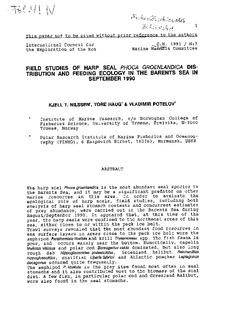| dc.description.abstract | The harp seal Phoca groenlandica is the most abundant seal species in
the Barents Sea, and it may be a significant predator on other
marine resources in this area. In order to evaluate the
ecological role of harp seals, field studies, including both
analysis of harp seal stomach contents and concurrent estimates
of prey abundance, were carried out in the Barents Sea during
August/September 1990. It appeared that, at this time of the
year, the harp seals were confined to the northmost areas of this
sea, either close to or within the pack ice belt.
Trawl surveys revealed that the most abundant food resources in
sea surface layers in areas close to the pack ice belt were the
amphipod Parathemisto libellula and krill Thysanoessa spp. The fish fauna is
poor, and occurs mainly near the bottom. Numerically, capelin
Mallotus villosus and polar cod Boreogadus saida dominated, but also long
rough dab Hippoglossoides platessoides, Greenland halibut Reinhardtius
hippoglossoides, snailfish Liparis fabricii and Atlantic poacher Leptagonus
decagonus occured quite frequently.
The amphipod P. libellula is the prey item found most often in seal
stomachs and it also contributed most to the biomass of the seal
diet. A few fish, in particular polar cod and Greenland halibut,
were also found in the seal stomachs. | no_NO |
